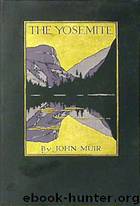The Yosemite by John Muir

Author:John Muir [Muir, John]
Language: eng
Format: mobi
Tags: Audiobook, Adventure, Nature
Publisher: manybooks.net
Chapter 8
The Flowers
Yosemite was all one glorious flower garden before plows and scythes and trampling, biting horses came to make its wide open spaces look like farmers' pasture fields. Nevertheless, countless flowers still bloom every year in glorious profusion on the grand talus slopes, wall benches and tablets, and in all the fine, cool side-canyons up to the rim of the Valley, and beyond, higher and higher, to the summits of the peaks. Even on the open floor and in easily-reached side-nooks many common flowering plants have survived and still make a brave show in the spring and early summer. Among these we may mention tall oenotheras, Pentstemon lutea, and P. Douglasii with fine blue and red flowers; Spraguea, scarlet zauschneria, with its curious radiant rosettes characteristic of the sandy flats; mimulus, eunanus, blue and white violets, geranium, columbine, erythraea, larkspur, collomia, draperia, gilias, heleniums, bahia, goldenrods, daisies, honeysuckle; heuchera, bolandra, saxifrages, gentians; in cool canyon nooks and on Clouds' Rest and the base of Starr King Dome you may find Primula suffrutescens, the only wild primrose discovered in California, and the only known shrubby species in the genus. And there are several fine orchids, habenaria, and cypripedium, the latter very rare, once common in the Valley near the foot of Glacier Point, and in a bog on the rim of the Valley near a place called Gentry's Station, now abandoned. It is a very beautiful species, the large oval lip white, delicately veined with purple; the other petals and the sepals purple, strap-shaped, and elegantly curled and twisted.
Of the lily family, fritillaria, smilacina, chlorogalum and several fine species of brodiaea, Ithuriel's spear, and others less prized are common, and the favorite calochortus, or Mariposa lily, a unique genus of many species, something like the tulips of Europe but far finer. Most of them grow on the warm foothills below the Valley, but two charming species, C. coeruleus and C. nudus, dwell in springy places on the Wawona road a few miles beyond the brink of the walls.
The snow plant (Sarcodes sanguinea) is more admired by tourists than any other in California. It is red, fleshy and watery and looks like a gigantic asparagus shoot. Soon after the snow is off the round it rises through the dead needles and humus in the pine and fir woods like a bright glowing pillar of fire. In a week or so it grows to a height of eight or twelve inches with a diameter of an inch and a half or two inches; then its long fringed bracts curl aside, allowing the twenty- or thirty-five-lobed, bell-shaped flowers to open and look straight out from the axis. It is said to grow up through the snow; on the contrary, it always waits until the ground is warm, though with other early flowers it is occasionally buried or half-buried for a day or two by spring storms. The entire plant--flowers, bracts, stem, scales, and roots--is fiery red. Its color could appeal to one's blood. Nevertheless, it is a singularly cold and unsympathetic plant.
Download
This site does not store any files on its server. We only index and link to content provided by other sites. Please contact the content providers to delete copyright contents if any and email us, we'll remove relevant links or contents immediately.
Giovanni's Room by James Baldwin(5872)
The Plant Paradox by Dr. Steven R. Gundry M.D(2035)
The Stranger in the Woods by Michael Finkel(1917)
Miami by Joan Didion(1877)
DK Eyewitness Top 10 Travel Guides Orlando by DK(1811)
Vacationland by John Hodgman(1772)
Trail Magic by Trevelyan Quest Edwards & Hazel Edwards(1757)
Wild: From Lost to Found on the Pacific Crest Trail by Cheryl Strayed(1731)
INTO THE WILD by Jon Krakauer(1719)
The Twilight Saga Collection by Stephenie Meyer(1717)
Nomadland by Jessica Bruder(1680)
Birds of the Pacific Northwest by Shewey John; Blount Tim;(1601)
Portland: Including the Coast, Mounts Hood and St. Helens, and the Santiam River by Paul Gerald(1579)
The Last Flight by Julie Clark(1487)
On Trails by Robert Moor(1474)
Deep South by Paul Theroux(1474)
Trees and Shrubs of the Pacific Northwest by Mark Turner(1423)
Blue Highways by William Least Heat-Moon(1373)
1,000 Places to See in the United States and Canada Before You Die (1,000 Places to See in the United States & Canada Before You) by Patricia Schultz(1292)
